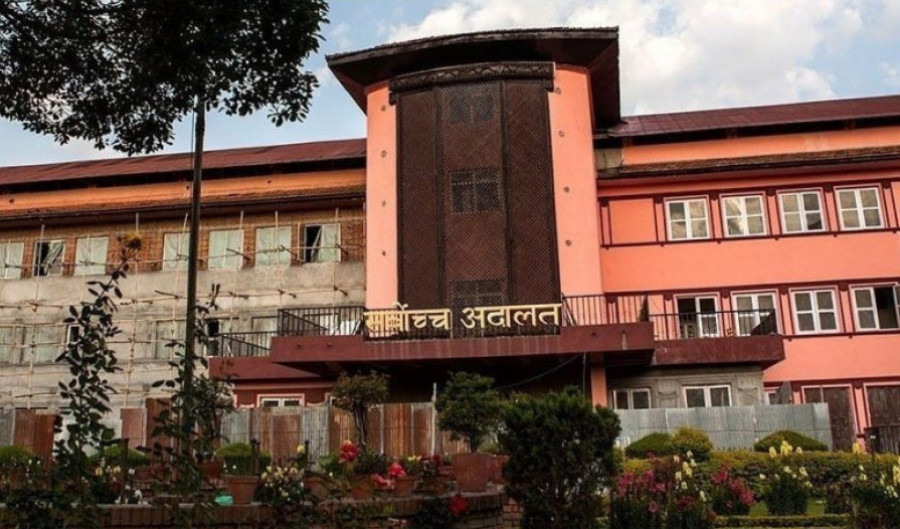Politics
Court verdict on Nepal Communist Party (NCP) and possible after-effects
The decision has revived the CPN-UML and the Maoist Centre, thereby leading to a split in the Dahal-Nepal faction and opening up myriad possibilities.
Post Report
Passing a verdict on an almost-three-year-old case, the Supreme Court on Sunday said that the Nepal Communist Party (NCP) registered with the Election Commission is illegitimate. In saying so, a division bench of Justices Kumar Regmi and Bom Kumar Shrestha issued a certiorary order to the Election Commission quashing its decision to award the Nepal Communist Party (NCP) to KP Sharma Oli and Pushpa Kamal Dahal. Reinstating the CPN-UML and the Communist Party of Nepal to their pre-merger state, the bench also issued an order of mandamus to the Election Commission to invite both the parties if they want to merge [again] as per existing laws. On Monday evening, those from the UML who were with Dahal decided to return home, leaving the Maoist Centre.
On Tuesday, the Election Commission scrapped the Nepal Communist Party (NCP).
Here is everything you need to know about the Supreme Court decision and its possible implications.
What is the dispute about?
Dandapani Poudel, an advocate, on December 7, 2018, filed a writ petition, on behalf of Rishiram Kattel, against the Election Commission challenging its decision to recognise and register the Nepal Communist Party (NCP), with NCP within brackets, under the names of KP Sharma Oli and Pushpa Kamal. The petitioner argued that the Election Commission had awarded the party name to Oli and Dahal despite a party with a similar name already registered with it, under Kattle’s name.
What is the Nepal Communist Party (NCP)?
The CPN-UML, led by Oli, and the Communist Party of Nepal (Maoist Centre), led by Dahal, in October 2017, days ahead of general elections, announced an electoral alliance. The two communist forces swept the polls held in November-December that year. Oli became prime minister with the support of the Maoist Centre in February 2018. In May 2018, both parties announced a merger and formed the Nepal Communist Party. But when they approached the Election Commission for the party registration, the poll body initially refused to register it saying a party with the same name was already registered, under Kattel’s name. The two parties–the UML and the Maoist Centre–were in power together and commanded a nearly two-thirds majority. After the initial refusal, they again approached the Election Commission–this time by adding NCP within brackets, making their party name Nepal Communist Party (NCP). The Election Commission agreed to register it in June 2018.
When was Kattel’s Nepal Communist Party registered?
Kattel, 70, a long-time communist leader, had registered the Nepal Communist Party in his name in 2013. Kattel, who was with the CPN-UML earlier, had in 1998 joined Bamdev Gautam’s CPN-ML. But after Gautam returned to the CPN-UML, he stayed with CP Mainali who continued to lead the CPN-ML. Later, Kattel joined CPN (Unified), along with Pari Thapa and Ram Singh Shrish. When Thapa and Shrish decided to join the Mohan Baidya-led CPN (Revolutionary Maoists) in 2012 when Baidya, along with Netra Bikram Chand—who last week returned to peaceful politics after remaining “underground” for two years—and Ram Bahadur Thapa, the incumbent home minister, left the Dahal-led Maoist party, Kattel registered “Nepal Communist Party” at the Election Commission in 2013.
Why and when did everyone suddenly start talking about Kattel’s party?
Even though Kattel had challenged the Election Commission's decision to award Nepal Communist Party (NCP) to Oli and Dahal in 2018, the case remained pending for various reasons. But on February 25, the Supreme Court conducted the first and only hearing and decided to pass a verdict on March 4. Speculations were rife about the future course of politics if the Supreme Court did pass a verdict in Kattel’s favour. The court passed the verdict on Sunday.
How can the court verdict impact national politics?
With the court not only reviving the UML and the Maoist Centre, but also annulling their merger, many technical questions remain unanswered. For example: What will be the fate of those who were elected to various posts under the Nepal Communist Party (NCP)? Sixteen members were elected to the National Assembly, one to the House of Representatives, and 29 to various local body posts. But that apart, the court judgment has clearly distinguished between the UML and the Maoist Centre, thereby making them two parties in Parliament.
Who controls how many seats in the lower house?
The UML had won 121 seats in the 2017 elections, while the Maoists had won 53.
Will Oli have to resign?
Not immediately. If the UML is considered to be “one” in entirety, there are 120 members (one member is dead) in Parliament. If the Maoist Centre withdraws its support, Oli will have to seek a vote of confidence. For Oli to survive in the House where 135 is the magic number,
i. Oli needs to garner the support of the Rashtriya Janata Party, which has 34 members (two suspended).
ii. Oli will have to seek the support of the Nepali Congress which has 63 members (two suspended)
What are the other scenarios?
If neither Congress nor the Janata Samajbadi Party supports Oli’s vote of confidence, both parties with the support of the Maoist Centre can form a government. The three can easily achieve the magic number of 135 as they together will have 146 (61+32+53) seats.
Are mid-term polls possible?
If the Maoist Centre withdraws support to Oli and the Congress and Janata Samajbadi Party do not support his vote of confidence, he will have to resign. In that case, the UML can stake a claim to form a government showing a majority as per Article 76 (3).
But a prime minister elected in such a way will have to seek a vote of confidence within 30 days.
If both Congress and Janata Samajbadi or either of them extends support, Oli can claim for the government formation as per Article 76 (2).
If not, any member who presents a ground on which he or she can obtain a vote of confidence in the House of Representatives can be appointed prime minister by the President under Article 76 (5). The member claiming the prime ministerial position must have the support of a minimum of 138 lawmakers. But a prime minister elected in such a manner must obtain a vote of confidence in 30 days. If that doesn’t happen, the House is dissolved and fresh elections are called which must elect a new House of Representatives within six months.




 7.12°C Kathmandu
7.12°C Kathmandu












%20(1).jpg&w=300&height=200)

